Ten Questions: An Interview With Jim and Carson Clark |
NPN Editor-in-Chief Richard Bernabe recently interviewed the father/son team of Jim and Carson Clark, who had just returned from a two-week photo trek in Yellowstone National Park. Jim is contributing editor for Outdoor Photographer Magazine, while his eleven-year old son Carson is an international award-winning photographer and author. Carson won his first major photography award when he was only six and published his first book when he was ten.
A big welcome to Nature Photographers Online Magazine to both of you. Carson, let's start with you. You're only eleven now, but at what age did you first pick up a camera?
I started using a camera when I was only three years old. I saw my dad using his cameras and I just became interested in doing it too. I got into photography by just using play cameras at first and then Dad let me have a little Nikon Coolpix 2500 camera. As I got more into photography, my mom and dad got me a Nikon D50, then a Nikon D80, which I used for my first book. Now Iím using a Nikon D90 and Iím also starting to use my dadís D300s and D700. I get to use dadís lenses too!
Aside from your dad, what other people or influences have led you to where you are now?
My mom has been a big influence in my life for many reasons. First, sheís my mother! And she always encourages me to try new things and to get better at what I do. Also, mom works hard every day to protect the wildlife and special places that all nature photographers photograph. We all should thank her for that.
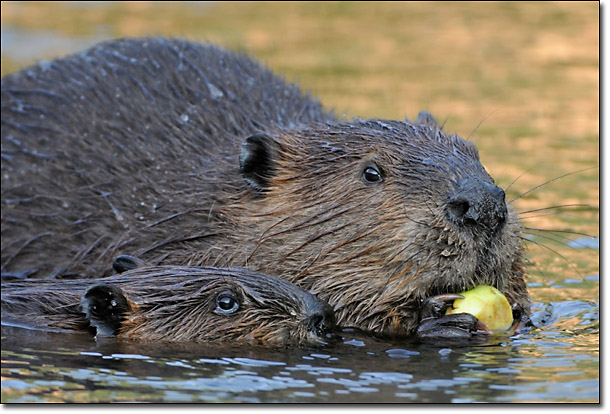
Beaver Adult and Yearling © Carson Clark
How did the idea of Buddy the Beaver come about?
One day in Yellowstone National Park, my mother suggested to dad and I that we should do a book together. Dad already had a few books published, so we decided to do one together after our trip. We knew about a beaver dam at a local nature park near our home in Virginia. That was the beginning of the project. I was eight years old at the time. We got some sponsors for the book project too. Lowepro, Hunts Photo and Manfrotto all provided photography gear for me to use. That was cool. I spent lots of time learning about beaver ecology and natural history, and thatís before dad and I went out to photograph them. The beaver dam was soon abandoned, but we were able to find a family of beaver living near my grandmotherís and uncles home in southern West Virginia. So, for two years, Dad and I would go there twice each summer to photograph. We also traveled through Virginia, West Virginia, and Maryland to photograph the other characters for the book. That was a lot of fun, especially when dad and I stayed at the state park lodges. I got to play video games and go swimming where we werenít photographing. Sometimes you have to take a break. To write the story, Dad and I would go to a local restaurant every Friday after school and start writing about Buddy and his friends. This was the hardest part of the project, next to editing the images.
Who is Buddy and what is the basic storyline?
Buddy is a little beaver who goes out to explore his pond one day. He meets many new friends and many of his old friends. He learns about what they do and he also learns that each has a special talent. So itís a story about friendship and accepting others for who they are. We have nearly finished the second book in the series, ďMystery of the Missing Friends.Ē Buddy learns about migration and hibernation. We hope to have this book out next spring or summer. We also have three more we want to do!
Carson, in addition to your book, what are some other accomplishments youíve made in your short ďcareer?Ē
At age six I became the youngest winner ever in Natureís Best International Photography Contest with an image of a monarch butterfly in flight. That same image was used for the front cover of my schoolís annual calendar and was used as the cover image for Emmy-award winning composer Gary Malkinís CD ďThe Calling Ė Songs from the Heart.Ē In 2008, I won first place in the Animals Category for the Washington Post Youth Photography Contest. Last year I won second place in the same contest and I also received a Highly Honored Award from the Veolia/BBC Youth Photography Contest. For the past four years I have also been a guest speaker with my dad at several events around the country. Last February I was the opening speaker at the annual conference of the North American Nature Photography Association in Reno, Nevada. I was only ten and I got to take the whole week off from school! But I still had to do my homework at night. I have also been a guest speaker at the Meadowlark Photo Expo, Grandfatherís Mountain Nature Photography Weekend, and the West Virginia Youth Conservation Camp.
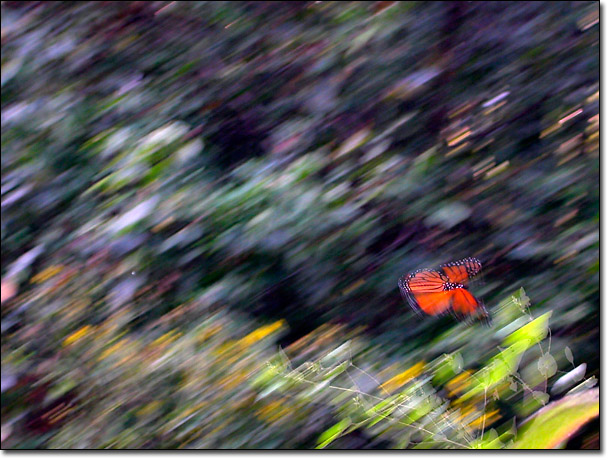
Monarch Butterfly in Flight © Carson Clark
How did you make the Monarch Butterfly in Flight photo?
I had just turned six and I asked my dad if we go to Banshee Reeks Nature Preserve and play like we were nature photographers. Of course dad is a nature photographer, but he was excited that I wanted to do it. So I got dressed up in my nature photography outfit and with my Nikon Coolpix camera, I followed a single monarch butterfly around a meadow. When dad saw the picture I had taken, he just smiled and said that picture is going to go places. I was just happy to be outside playing and photographing.
Jim, in your opinion, how important is it to have kids get involved with nature and the outdoors at an early age?
To excite our younger generation about nature is very important and itís especially critical now. There are less kids getting into nature and itís been proven time and time again that the more children participate in the outdoors, the more creative they become and the more their analytical skills improve. And I donít even have to mention the lost skill of patience in our young folks. Everything is so fast-paced these days that kids want and expect immediate satisfaction. Iím afraid we are losing a whole generation of our youth to the joys of nature observation and to the skill of patience. For Carson, his involvement in nature photography and observation has helped him learn how to be patient and to think things through. Itís wonderful to watch him photograph the wild animals in Yellowstone, from the smallest critter to our favorite, the bison. Heís excited by it all. Donít be mistaken, heís like every other kid today wanting all the latest technological gadgets and his cartoon shows on TV. But through hiking, nature photography, and just being with his mom and me, he has a deep appreciation and love for nature.
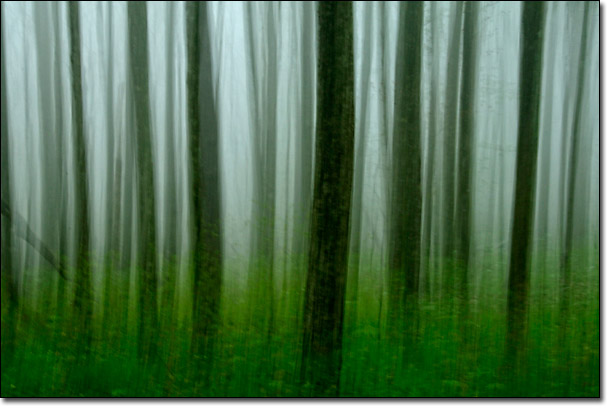
Abstract of Spring Forest © Jim Clark
What do you see as some of the obstacles they face growing up in this modern society?
One of the primary obstacles of course, is the many technological distractions that kids have at their immediate use. We are even losing our older generations to the addiction of cable television, internet, and digital games. If you read the book Last Child in the Woods by Richard Louv, youíll understand what Iím talking about. Louv calls it nature deficit disorder. Itís as if many kids today donít know what to do if they canít plug something into a wall socket or use batteries. Itís not every child mind you, but itís pervasive and an issue that many nature educators are trying to address.
Another major obstacle facing kids today is that even their parents are not engaged in any sort of nature appreciation. Sure there are outdoor activities, but in the area where we currently live (the Washington, D.C. area), thatís usually a soccer field or baseball diamond. For many parents, this is the wilderness and itís all the nature their kids need.
Our society has become predominantly urbanized; less folks are raised in the country and while it might not seem that way in Montana or West Virginia, itís a fact. Iíve led nature hikes for my sonís classes and I have had kids tell me that their parents donít want them to even sit on the grass. I even had one young boy tell me he got nothing out of taking a hayride to see a beaver dam. I suspect it was because he couldnít plug anything in to an electrical socket. Society is so fast-paced and itís a very demanding life out there for everyone, so how you and I experienced nature is totally different from today. Whereas we went into nature, many children today only experience it through shows on television.
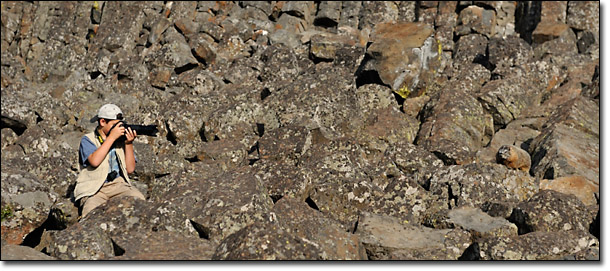
Carson photographing a marmot in Yellowstone National Park © Jim Clark
A few years back, Carson and I did a series of talks around the country. The program was called ďMy Child in the Woods,Ē and it was based on an interview I did with him when he was about eight. I ask him some basic questions which related to how to get his generation interested in nature. Here is what Carson told more than 200 resource professionals in the audience:
(1) ďI love nature because my parents love it. I especially like going on nature adventures with my parents.Ē For me that means, donít make nature a babysitter by letting the park ranger or education specialist do all the work. Get the parents involved.
(2) ďI like to just go out and have fun in nature, using my imagination and making pretend.Ē For me that means, donít always have a structured class or session in nature. Let kids go out and explore on their own. This is how they develop their imagination, their creativity, and their ingenuity. Itís amazing what can be learned by just having a stick, some mud, and maybe a tiny stream!
(3) ďI like using walkie-talkies.Ē When he told me this, he was about seven years old and I took that to mean, embrace the new technology and use it to get kids involved with nature. Walkie-talkies, binoculars, gps units, etc. all can be used to get children excited about the outdoors. When Carson was at Yellowstone this summer, he got to actually track some wolves using radio telemetry. He got to crawl completely inside an abandoned wolf den. He was so excited to do this and itís something that will further strengthen his love for nature.
Jim, you are a former president of NANPA and youíre still are very involved with this great organization. What, if anything, is NANPA doing with outreach to kids and young adults?
First, Iím proud to say Iím charter member 0005! Secondly, I was one of the original instructors and leaders of NANPAís high school student scholarship program, which brings ten students from around the country to spend the week at NANPA. The program has really grown to be a life-altering experience for these kids. This program has been very successful and it has now expanded to include a college scholarship program as well. When Carson and I were co-MCs of the 2010 NANPA conference in Reno (Carson, by the way, was the opening keynote speaker), we noticed that there were more youngsters attending the conference with their parents. So NANPA strives to do its part to involve the youth in not only nature photography, but nature appreciation as well. Can more be done? Of course, but it will take much more money and personal involvement by the membership to make that happen. I know many NANPA members who are involved with nature photography programs for children, including reaching out to the inner-city youth to get them excited about nature through photography.
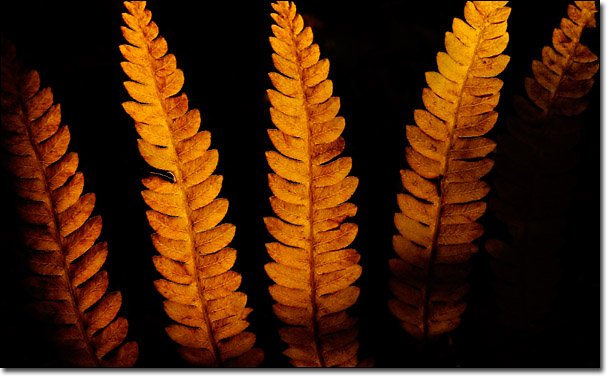
Ferns at Sunset © Jim Clark
Carson, what do you want to be when you grow up?
Ever since I was a little kid Iíve always wanted to a park ranger at Yellowstone National Park. We go there every summer to help my mom with a conservation workshop she has there and I have fallen in love with the park. We get to spend two weeks in the park and I love to explore and photograph the whole time. I especially would like to be the park ranger that lives in the cabin in Lamar Valley. Mammoth Hot Springs wouldnít be a bad place to be a park ranger either!
Comments on NPN nature photographer interviews? Send them to the editor. NPN members may also log in and leave their comments below.
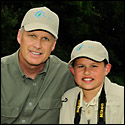 A contributing editor for Outdoor Photographer Magazine, Jim Clark is also the author and photographer of four books, including the childrenís book that he and Carson co-wrote and photographed, The Adventures of Buddy the Beaver. You can see more of Jim's photography, as well as his busy speaking and workshop schedule, at www.jimclarkphoto.com.
A contributing editor for Outdoor Photographer Magazine, Jim Clark is also the author and photographer of four books, including the childrenís book that he and Carson co-wrote and photographed, The Adventures of Buddy the Beaver. You can see more of Jim's photography, as well as his busy speaking and workshop schedule, at www.jimclarkphoto.com.
At age six, Carson Clark became the youngest winner ever in the Natureís Best Magazine Windland River International Photography Contest. Since that time, Carson has won awards from the Washington Post and the Veolia/BBC Youth Photographer of the Year Contest. He travels the country with his dad giving presentations about his life as a nature photographer and naturalist. Carson's website is www.carsonclarkphoto.com.